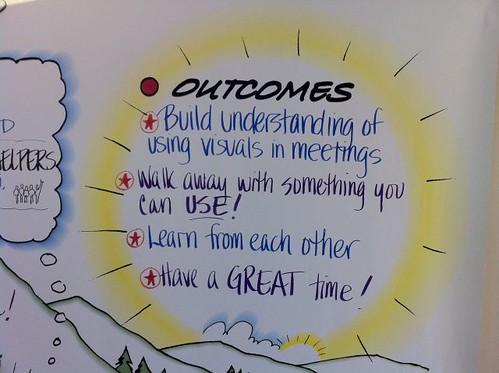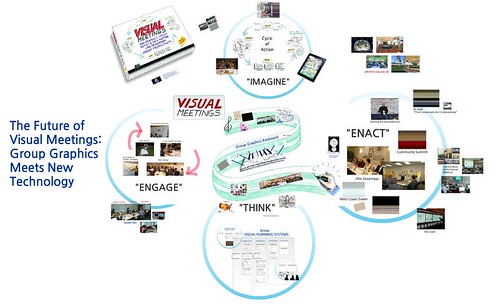
I’ve been a fan of visual thinking and graphic facilitation for many years – and have used the techniques to take notes for myself. As a visual learner, mindmapping, drawing, and other techniques to think visually have helped me learn, synthesize lots of data, and see patterns. I have also attended and facilitated meetings with a graphic recorder, most recently at the Nonprofit Technology Conference, and know the power of how “drawing on the wall” can help spark group insights and learning.
About a year ago, I came across David Sibbet’s book, “Visual Meetings” I have known of his work for years, but always thought graphic recording was for “real artists who can draw.’ The book was an inspiration and encouragement for those us whose inner critics have been keeping us away from using the technique in front of other people. The book offers a wonderful road map for a learning journey to internalize these techniques and I’ve practicing a lot. I haven’t made it to the top of the ladder where I can “draw on the wall” while facilitating a group, and I have not been able to become fluent in using visual note taking in digital ways – like on a iPad. That’s why I was probably the first person to register last January for the Visual Meetings Workshop with David Sibbet and Rachel Smith from Grove Consultants that took place this week in San Francisco.

My notes from the workshop follow below and I’ve created with Storify that includes the many resources I discovered that I will be exploring. I’ve set a new professional goal to improve my graphic recording and visual facilitation skills which requires a discipline of daily practice, starting with small simple steps and working towards more complex ones. I definitely walked away achieving all the outcomes for the meeting, most importantly being inspired to put this knowledge into practice.
One of the techniques that they used that I loved was to provide a graphic template for your personal learning journey to internalize these skills. While a one-day workshop can be fantastic, once you go back to your day to day craziness, it is hard to make that leap. The book offers a rubric of skills, starting with the most simple to the more complex. The other thing I learned, is that like anything else, to get good at this technique you have to practice until it is second nature. Rachel Smith, workshop co-facilitator, drove home this point when she shared with the group that she felt she was not good at drawing people – so she practice drawing people 600 times before using it for an assignment.
The workshop started with a role play of David and Rachel planning the agenda for the workshop, but simulating how you might do this over the Internet and using graphic recording. Rachel, a virtuoso technologist and artist, used a drawing tablet and Sketchbook pro. (Here’s an interview with Rachel about the techniques and a blog post the tools. Later in the workshop, they did a duo of graphic recording – with Rachel using the digital tools and Sibbet drawing on paper with markers.
Next was an icebreaker where we had to draw on a table tent – our names and the answer to this fill in the blank question: “I’m at my best when …” Icebreakers should always reinforce the outcomes in some way or skills being taught – and provide a way for people to get to know each other. This is especially important if there are small group exercises.

David Sibbet gave an overview of visual meetings and why it is so compelling now. He used PREZI, a non-linear presentation program. It goes beyond the linearity of powerpoint, but it to use it to present with takes getting to know the program well – and thinking about your storyboard and visuals as three-dimensional tick-tac-toe board. (I could not track down the PREZI, but in the TEDX video -you’ll hear the main points he made.) This segment was followed by small group work where we did a peer assist brainstorm on incorporating visual techniques into their next meeting. We used sticky notes and the mandala template. David modeled a full group discussion to gather up all the ideas – using a template that used the basic flows of facilitation – attention, energy, information, and operations.
The afternoon was focused on the skill building – drawing – images and letters. This is covered in the book in great depth, but it was great to have Rachel lead us through the drawing techniques, stroke by stroke. We ended with a Q/A Session. Rachel shared a number of techniques and tips on how to embrace digital graphic recording in the iPad. A couple of insights that inspired me:
- Graphic facilitation is not about being a good at drawing, but better at listening
- Don’t worry if it isn’t perfect – be thinking about what’s next
- Accept corrections like Christmas presents
- Be the fool in front the audience’s queen and king – don’t be afraid of public mistakes
- Practice, practice, practice is the key
- Using technology will always feel a little unnatural – but don’t let that get in your way
- Graphic facilitating encourages engagement and acknowledge of people in the room – it validates them
I feel inspired to add visual meetings to the curated list of skills and knowledge for trainers and capacity builders that I’m learning about.
There is a whole community of graphic facilitators and practitioners like Nancy White who are using these techniques with ngos.
Have you experimented or are you using graphic meeting facilitation for your nonprofit? Share your story below.
